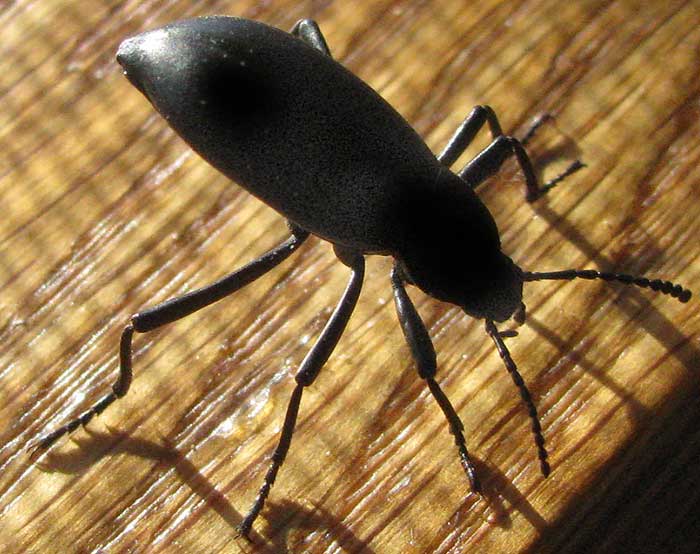Excerpts from Jim Conrad's
Naturalist Newsletter

from the October 14, 2012 Newsletter issued from the valley of the Dry Frio River in northern Uvalde County, southwestern Texas, on the southern border of the Edwards Plateau; elevation ~1750m (~5750 ft); N29.62°, W99.86°; USA
DESERT STINK BEETLE
Back when I was traveling the US Desert Southwest for my online book at http://www.backyardnature.net/desert/ I kept running into large, black beetles walking across the sand or dust with their rear ends much elevated above their heads. When disturbed they would raise their rear ends even higher. Picking some up I quickly figured out why high rear ends were so important to them: From their rear ends they could exude, even squirt, secretions so stinky that few predators would want to deal with it. Therefore, this week when a high-rear-ended black beetle appeared beneath a loose tile in the bathroom I knew what he was: A desert stink beetle, genus ELEODES. That's him above.
Saying that he's a desert stink beetle really isn't saying much, since about 200 Eleodes species currently are recognized, though the genus is endemic just to western North America south to central Mexico.
Despite knowing that so many look-alike desert stink beetles exist I sent our photograph to volunteer identifier Bea in Ontario, since sometimes she figures out even the most obscure things. However, this time she replied pointing out that "Within the state of Texas a total of 31 species are known to occur... I checked each and every one of the species and although some can be ruled out because they have a rounded abdomen and yours looks pointy, and yours also looks smooth instead of having ridges on the forewings, there are still too many it could be... "
I read that grasshopper mice have been observed getting around the stinking rear ends by jamming beetle behinds into the sand and eating the insect head first. Other predators somehow able to deal with the odor include burrowing owls, Loggerhead Shrikes and skunks.
Notwithstanding all this talk of stinking rear ends, I sniffed our beetle's behind and didn't smell a thing. I do recall, however, some magnificent stinks caused by beetles encountered in more natural situations, and I've been squirted with the stink, too. I read that some of the larger desert species can spurt their juice up to 20 inches (50cm).